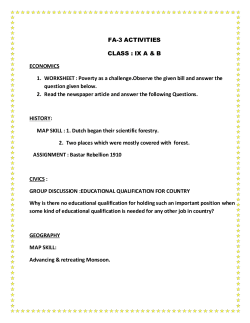
Subsea Processing-Mapping the way forward
Subsea Processing in Field Development And the Value Proposition JOHN ALLEN MCE March 2015 It’s Complicated Subsea Processing is about the: reservoir concept selection (subsea or not subsea and the topsides) the subsea production system, including flow assurance and the host and processing And, it is a full system, life-of-field issue Integrated production modeling Minimizing well count whilst maximizing recovery Incorporating ‘new’ and emerging technology for increased recovery, but manage risk with knowledge It is Complicated and Complex Managing Risk is understanding the qualification of the equipment and the integrated system – the regulatory environment and ‘standards’ API RP 17A, Design and Operation of Subsea Production Systems General Requirements and Recommendations API 17N Subsea Reliability and Integrity Management API 17Q Qualification API 17X Subsea Pumping (testing and RAM) Other initiatives, DnV (RP A203 Qualification), ISO13628-1 (Subsea), IOGP, DeepStar, ITF…. Subsea Electrical Power SEPS; Subsea Instrumentation SIIS; SSP Specifications….. Standardization Initiative (SPE)- Standardize as early as possible (the innovation quandary) ITF Subsea Processing Network-Role out OTC 2015 Managing Complexity Full life-of-field system modeling from reservoir to host at the field development stage both performance and economic modelling Enabled by the new generation of analysis tools (MAXIMUS™) for ACCURATE and rapid evaluation of various subsea processing options Subsea Processing is Global 2015 Subsea Processing Poster Source: 2013 Worldwide Survey of Subsea Processing: Separation, Compression, and Pumping Systems; Offshore Magazine poster #104 What is driving the full realization What is limiting the next big steps Subsea Power Systems: Shifting from Single Drop – Single Load To Subsea Distribution For Multiple Loads at Longer Distances Topsides platforms can be consolidated. Further concept scenarios and optimizations are possible. Increased production & recovery – Reduced CAPEX Full Lifecycle Potential Åsgard additional production ~ 280 mboe …potentially $28 billion Images courtesy of BHP Billiton Assesing Risk the Regulation Instruments API RP 17A, Design and Operation of Subsea Production Systems - General Requirements and Recommendations: Provides a composite overview of subsea production systems and their use for hydrocarbon production, from the design phase to decommissioning and abandonment. It includes tutorial content to educate users with limited subsea production experience. Appendix A identifies and defines different categories of standard testing and qualification testing and defines common terminology. As referenced in API 17A, the specific term “technology qualification” is defined in DNV-RP-A203:2011 as:2.1.1 Technology qualification is the process of providing the evidence that a technology will function within specified operational limits with an acceptable level of confidence. Assessing Risk the Regulation Instruments API RP 17N (2nd edition), Subsea Production System Reliability, Technical Risk and Integrity Management: Reliability and Integrity Management are critical to subsea production system design and operations. This Recommended Practice provides a comprehensive approach to help ensure that subsea system reliability and integrity requirements are defined planned and achieved throughout the design and operational life cycle. Comprehensive appendices are provided with detailed guidance on; qualification of new Technology; technical risk and uncertainty categorization; application of test statistics; reliability and integrity key processes; example reliability work scopes, data collection. It is broadly referenced in the deepwater technical community as a foundation document for addressing reliability, Integrity and qualification of technology. The Qualification of Technology Process Courtesy Astrimar Qualification Basis New Technology Specification (Qualification Basis) DNV RP A203 API 17N Initial Qualification Plan Technology Assessment Technology Assessment (TRL & FMECA) Threat Assessment Execution of Plan Assess and Correct Modifications Interpret TRL for different applications, Tests relate to the stage of development Modifications Update Qualification Plan API 17N (2015) Qualification Plan Execution of Plan Performance Assessment No Requirements Met? Yes Assurance & Residual Risk Qualification Complete Assesing Risk the Regulation Instruments API RP 17Q, Subsea Equipment Qualification (TBD): Provides detailed guidance on the qualification of new or modified subsea equipment or existing equipment to be used in new applications. The recommended practice includes descriptions and guidance related to; technology readiness level (TRL) for hardware and software; qualification FMECA; activities needed to progress from initial to required TRL, TRL advancement degree of difficulty, qualification testing and analysis methods for mechanical, structural hydraulic and electrical hardware, application of test statistics for reliability assessment and reliability growth, Qualification basis, planning and assurance documentation. Assesing Risk the Regulation Instruments API RP 17O, Subsea High Integrity Pressure Protection Systems (HIPPS): This RP establishes criteria for HIPPS systems that are seeing increased utilization in industry as a means to safely provide overall system pressure capability while restricting the section that requires full shut-in pressure rating to a segment that is close to the source. API RP 17X, Subsea Boosting – Design, Testing and Qualification: Currently under development, this document will provide applicable criteria for the design, manufacture, testing, installation, and operation of subsea pumps and boosting equipment to help ensure effective and reliable performance. Other API SSP guidance may be forthcoming as other areas of Subsea Processing evolve and mature What might the future hold? Its all about economics DISAPPEARING TOPSIDES We are getting standardized and integrated OneSubsea Helico-Axial Pump. OneSubsea’s multiphase pump stages in a vertical configuration. Recent testing and successful qualification work, in the HiBoost MPP Joint Industry Project, have greatly increased differential head capability. Image Courtesy OneSubsea Aker Solutions Aasgard Subsea Compressor Train with 11.5 MW Compressor Module, Separator, Cooler and Pump Module Image Courtesy of Aker Solutions What might the future hold? Thank you for your attention. For additional information please contact: Larry Forster US at larry.forster@intecsea.com Phil Cooper UK at Philip.cooper@intecsea.com Ian Ball UK at ian.ball@intecse.com
© Copyright 2025










